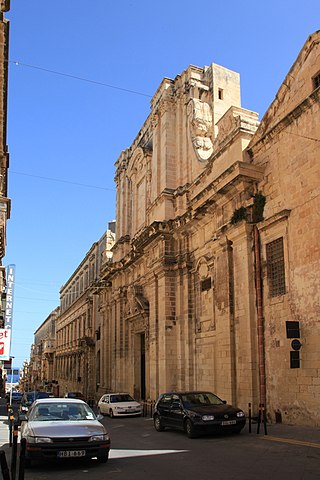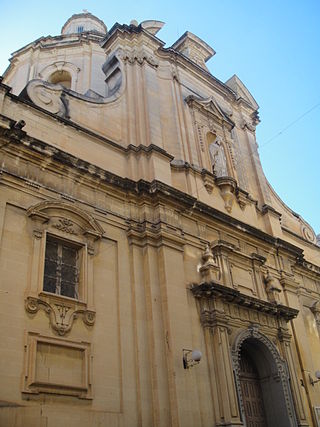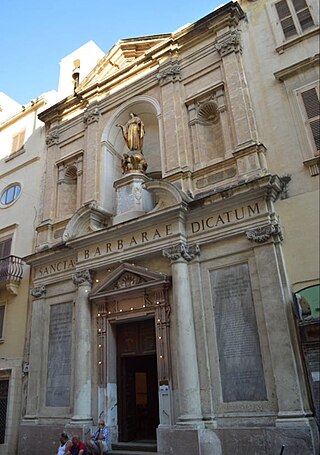
The Grandmaster's Palace, officially known as The Palace, is a palace in Valletta, Malta. It was built between the 16th and 18th centuries as the palace of the Grand Master of the Order of St. John, who ruled Malta from 1530 to 1798, and was also known as the Magisterial Palace. When the knights were expelled by Napoleonic France, it became the National Palace. During the period of British rule beginning in 1800, it was the Governor's Palace.

The Our Lady of Victory Church, formerly known as the Saint Anthony the Abbot Church, was the first church and building completed in Valletta, Malta. In 1566, following the Great Siege of Malta, Grand Master Jean Parisot de Valette and his Order showed interest to build a church in the name of the Nativity of the Virgin as a form of thanksgiving; the construction was funded by De Valette.

St Francis of Assisi Church, dedicated to St Francis of Assisi, in Valletta, was built in 1598 and was completed by 1607.

The Church of the Circumcision of Our Lord, also known as the Church of the Jesuits or the Church of the University, is one of the oldest and largest churches in Valletta, Malta. It was originally built between 1593 and 1609 by the Jesuit order, and it is located adjacent to the Old University Building, which originally housed a Jesuit college known as the Collegium Melitense. The church was rebuilt in the Baroque style by Francesco Buonamici after suffering extensive damage in an explosion in 1634. The church remained in use after the Jesuits were expelled from Malta in 1768, and it is also used for Masters and Doctoral graduation ceremonies of the University of Malta, the successor to the Collegium.

St. George's Basilica or the Basilica and Collegiate Parish Church of Saint George, also simply known as San Ġorġ in Maltese, is a historic Baroque church situated in the middle of Gozo, the second largest island in the Maltese archipelago, and is surrounded by a maze of old narrow streets and alleys. Today's basilica was built between 1672 and 1678.

The Metropolitan Cathedral of Saint Paul, commonly known as St Paul's Cathedral or the Mdina Cathedral, is a Catholic cathedral in Mdina, Malta, dedicated to St. Paul the Apostle. The cathedral was founded in the 12th century, and according to tradition it stands on the site of where Roman governor Publius met St. Paul following his shipwreck on Malta. The original cathedral was severely damaged in the 1693 Sicily earthquake, so it was dismantled and rebuilt in the Baroque style to a design of the Maltese architect Lorenzo Gafà between 1696 and 1705. The cathedral is regarded as Gafà's masterpiece.

The Nibbia Chapel was a Roman Catholic chapel in Valletta, Malta, which was dedicated to Our Lady of Mercy. It was originally built in 1619 by Fra Giorgio Nibbia, a knight of the Order of St. John, and it was located near a cemetery where deceased patients from the nearby Sacra Infermeria were buried.

The Church of Saint Nicholas, also known as the Church of All Souls, is a Greek Catholic church in Valletta, Malta, dedicated to Saint Nicholas. Originally built as a Greek Orthodox church in 1569, it was conceded to the Confraternity of the Souls in Purgatory in 1639, who rebuilt the church in the Baroque style in 1652. The church was passed back to the Greek Catholic congregation in 2014 however the church is used from Ecumenical Patriarchate of Constantinople.

The Church of Our Lady of the Pillar is a 17th-century church located in Valletta, Malta. The church was built as the church of the Aragonese knights and modeled according to the plans of the architect Romano Carapecchia. The church is listed on the National Inventory of the Cultural Property of the Maltese Islands.

The Basilica of Our Lady of Mount Carmel is a Carmelite Roman Catholic minor basilica dedicated to Our Lady of Mount Carmel, located in Valletta, Malta. It is one of the major churches of Valletta, and it forms part of a UNESCO World Heritage Site which includes the entire city. The present church was constructed between 1958 and 1981 on the site of a late 16th century church which was destroyed during World War II.

The Church of St Barbara is a Roman Catholic church situated in Valletta, Malta. The church was built to service the spiritual needs of the knights of Provence.

The Church of St Lucy is a small Roman Catholic church situated in Valletta, Malta. The church was built in 1570 and features a titular painting above the high altar and the corpse of St Lucian, the martyr.

The Parish Church of St Andrew is a Roman Catholic parish church located in Luqa, Malta.

The Banca Giuratale, formerly also known as Banca dei Giurati, the Municipal Palace, the Palazzo della Città, Casa Città and the Consolato del Mare, is a public building in Valletta, Malta. It was built in the 18th century to house the city's administrative council, and it was subsequently used as the General Post Office and the Public Registry. The Banca Giuratale now houses the Ministry for the Economy,Enterprise and Strategic Projects, and it is officially known as Palazzo Zondadari.

Spinola Palace, also known as Spinola House, is a palace in Valletta, Malta. It belonged to the Spinola family between the 17th and 18th centuries. One third of the building was demolished in the 20th century, but the remaining two wings still exist and are now used as the head office of Lombard Bank.

The Church of Our Lady of Liesse is a church in Valletta, Malta. The church was built in 1740 on the site of a 17th-century church. The cupola was built to the designs of the Maltese Architect Francesco Zammit. The church is located near the shores of the Grand Harbour, close to Lascaris Battery and the site of the fish market. It is especially venerated by the people of the port area.

The Saint Publius Parish Church, also known as the Floriana Parish Church is a Roman Catholic parish church in Floriana, Malta, dedicated to Saint Publius. It was constructed at several stages between the 18th and 20th centuries.

Maltese Baroque architecture is the form of Baroque architecture that developed in Malta during the 17th and 18th centuries, when the islands were under the rule of the Order of St. John. The Baroque style was introduced in Malta in the early 17th century, possibly by the Bolognese engineer Bontadino de Bontadini during the construction of the Wignacourt Aqueduct. The style became popular in the mid to late 17th century, and it reached its peak during the 18th century, when monumental Baroque structures such as Auberge de Castille were constructed.
Romano Fortunato Carapecchia (1666–1738) was an Italian Baroque architect who was active in Rome, Malta and Sicily. His designs helped transform Malta's capital Valletta into a Baroque city in the first few decades of the 18th century.

St Catherine's Monastery is a monastery in Valletta, Malta which houses cloistered nuns of the Second Order of Saint Augustine. It incorporates the Church of the Presentation of Our Lady, which is more commonly known as the Church of St Catherine. The church and monastery were built in the 18th century and they replaced a previous monastery which had been housed in a 16th-century palace.





















